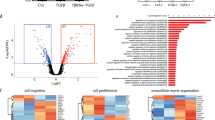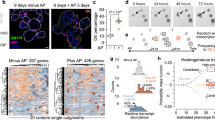Abstract
Although the multi-functional, prosurvival protein, Bcl-2-associated anthanogene 1 (BAG-1) is frequently overexpressed in breast cancers, its role in the development or maintenance of the malignant state remains unclear. Here, we have used the established MCF-10A 3-dimensional (3D) model of mammary morphogenesis as a biologically relevant system to determine how BAG-1 expression may influence the development of breast cancer. When cultured in 3D, MCF-10A cells undergo a highly regulated morphogenic program leading to the development of polarized acinar structures containing a central, hollow lumen formed, in part, through the induction of BIM-dependent apoptosis. BAG-1 overexpression resulted in an attenuation of this normal apoptotic program characterized by a significantly increased number of acini with filled lumens—a phenotype commonly observed in ductal carcinoma in situ. BAG-1's effects were associated with an activation of RAF-1—a known binding partner of BAG-1, enhanced signaling through the MAP kinase pathway and a decrease in BIM expression. Reversal of the BAG-1-associated survival phenotype by the mitogen-activated kinase/ERK kinase inhibitor, U0126, implicates the RAF-1–extracellular signal-regulated kinase signaling pathway as a major mediator of BAG-1's effects in this model. As BAG-1 expression is often elevated in preinvasive breast cancers, these findings support a possible role for BAG-1 as an early contributor to the malignant process in the breast.
This is a preview of subscription content, access via your institution
Access options
Subscribe to this journal
Receive 50 print issues and online access
$259.00 per year
only $5.18 per issue
Buy this article
- Purchase on Springer Link
- Instant access to full article PDF
Prices may be subject to local taxes which are calculated during checkout







Similar content being viewed by others
Abbreviations
- BAG-1:
-
Bcl-2-associated anthanogene
- ERK:
-
extracellular signal regulated kinase
- MEK:
-
mitogen-activated kinase/ERK kinase
- ER:
-
estrogen receptor
- DCIS:
-
ductal carcinoma in situ
- 3D:
-
three-dimensional
- DAPI:
-
4′,6-diamidino-2-phenylindole
References
Arhel NJ, Packham G, Townsend PA, Collard TJ, H-Zadeh AM, Sharp A et al. (2003). The retinoblastoma protein interacts with Bag-1 in human colonic adenoma and carcinoma derived cell lines. Int J Cancer 106: 364–371.
Avruch J, Zhang XF, Kyriakis JM . (1994). Raf meets Ras: completing the framework of a signal transduction pathway. Trends Biochem Sci 19: 279–283.
Blagosklonny MV, Wu GS, Omura S, el-Deiry WS . (1996). Proteasome-dependent regulation of p21WAF1/CIP1 expression. Biochem Biophys Res Commun 227: 564–569.
Brimmell M, Burns JS, Munson P, McDonald L, O′Hare MJ, Lakhani SR et al. (1999). High level expression of differentially localized BAG-1 isoforms in some oestrogen receptor-positive human breast cancers. Brit J Cancer 81: 1042–1051.
Brummer T, Schramek D, Hayes VM, Bennett HL, Caldon CE, Musgrove EA et al. (2006). Increased proliferation and altered growth factor dependence of human mammary epithelial cells overexpressing the Gab2 docking protein. J Biol Chem 281: 626–637.
Caldon CE, Swarbrick A, Lee CS, Sutherland RL, Musgrove EA . (2008). The helix-loop-helix protein Id1 requires cyclin D1 to promote the proliferation of mammary epithelial cell acini. Cancer Res 68: 3026–3036.
Cutress RI, Townsend PA, Sharp A, Maison A, Wood L, Lee RS et al. (2003). The nuclear BAG-1 isoform, BAG-1L, enhances oestrogen-dependent transcription. Oncogene 22: 4973–4982.
Debnath J, Brugge J . (2005). Modelling glandular epithelial cancers in three-dimensional cultures. Nature Reviews Cancer 5: 675–688.
Debnath J, Mills KR, Collins NL, Reginato MJ, Muthuswamy SK, Brugge J . (2002). The role of apoptosis in creating and maintaining luminal space within normal and oncogene-expressing mammary acini. Cell 111: 29–40.
Debnath J, Muthuswamy SK, Brugge J . (2003). Morphogenesis and oncogenesis of MCF-10A mammary epithelial acini grown in three-dimensional basement membrane cultures. Methods 30: 256–268.
Elliott E, Ginzburg I . (2009). BAG-1 is preferentially expressed in neuronal precursor cells of the adult mouse brain and regulates their proliferation in vitro. FEBS Lett 583: 229–234.
Froesch BA, Takayama S, Reed JC . (1998). BAG-1 L protein enhances androgen receptor function. J Biol Chem 273: 11660–11666.
Hanahan D, Weinberg RA . (2000). The hallmarks of cancer. Cell 200: 57–70.
Harris JR, Lippman ME, Morrow M, Osborne CK . (1999). Diseases of the breast. Lippincott Williams and Wilkins: Philadelphia.
Höhfeld J . (1998). Regulation of the heat shock conjugate Hsc70 in the mammalian cell: the characterization of the anti-apoptotic protein BAG-1 provides novel insights. Biol Chem 379: 269–274.
Kolch W . (2000). Meaningful relationships: the regulation of the Ras/Raf/MEK/ERK pathway by protein interactions. Biochem J 351: 289–305.
Kudoh M, Knee DA, Takayama S, Reed JC . (2002). Bag1 proteins regulate growth and survival of ZR-75-1 human breast cancer cells. Cancer Res 62: 1904–1909.
Ley R, Balmanno K, Hadfield K, Weston C, Cook SJ . (2003). Activation of the ERK1/2 signaling pathway promotes phosphorylation and proteasome-dependent degradation of the BH3-only protein, Bim. J Biol Chem 278: 18811–18816.
Luciano F, Jacquel A, Colosetti P, Herrant M, Cagnol S, Pages G et al. (2003). Phosphorylation of Bim-EL by Erk1/2 on serine 69 promotes its degradation via the proteasome pathway and regulates its proapoptotic function. Oncogene 22: 6785–6793.
Mailleux AA, Overholtzer M, Brugge JS . (2008). Lumen formation during mammary epithelial morphogenesis: insights from in vitro and in vivo models. Cell cycle 7: 57–62.
Mailleux AA, Overholtzer M, Schmelzle T, Bouillet P, Strasser A, Brugge JS . (2007). BIM regulates apoptosis during mammary ductal morphogenesis, and its absence reveals alternative cell death mechanisms. Dev Cell 12: 221–234.
Meller R, Cameron JA, Torrey DJ, Clayton CE, Ordonez AN, Henshall DC et al. (2006). Rapid degradation of Bim by the ubiquitin–proteasome pathway mediates short-term ischemic tolerance in cultured neurons. J Biol Chem 281: 7429–7436.
Millar EKA, Anderson LR, McNeil CM, O′Toole SA, Pinese M, Crea P et al. (2008). BAG-1 predicts patient outcome and tamoxifen responsiveness in ER-positive invasive ductal carcinoma of the breast. Br J Cancer 100: 123–133.
Mueller H, Flury N, Eppenberger-Castori S, Kueng W, David F, Eppenberger U . (2000). Potential prognostic value of mitogen-activated protein kinase activity for disease-free survival of primary breast cancer patients. Int J Cancer 89: 384–388.
Muthuswamy SK, Li D, Lelievre S, Bissell MJ, Brugge JS . (2001). ErbB2, but not ErbB1, reinitiates proliferation and induces luminal repopulation in epithelial acini. Nat Cell Biol 3: 785–792.
Nadler Y, Camp RL, Giltnane JM, Moeder C, Rimm DL, Kluger HM et al. (2008). Expression patterns and prognostic value of Bag-1 and Bcl-2 in breast cancer. Breast Cancer Res 10: R35.
Packham G, Brimmell M, Cleveland JL . (1997). Mammalian cells express two differently localized Bag-1 isoforms generated by alternative translation initiation. Biochem J 328: 807–813.
Reginato MJ, Mills KR, Becker EBE, Lynch DK, Bonni A, Muthuswamy SK et al. (2005). Bim regulation of lumen formation in cultured mammary epithelial acini is targeted by oncogenes. Mol Cell Biol 25: 4591–4601.
Salh B, Marotta A, Matthewson C, Ahluwalia M, Flint J, Owen D et al. (1999). Investigation of the Mek–MAP kinase–Rsk pathway in human breast cancer. Anticancer Res 19: 731–740.
Sharp A, Crabb SJ, Townsend PA, Cutress RI, Brimmell M, Wang XH et al. (2004). BAG-1 in carcinogenesis. Expert Rev Mol Med 6: 1–15.
Sivaraman VS, Wang H, Nuovo GJ, Malbon CC . (1997). Hyperexpression of mitogen-activated protein kinase in human breast cancer. J Clin Invest 99: 1478–1483.
Song J, Takeda M, Morimoto RI . (2001). Bag1-Hsp70 mediates a physiological stress signalling pathway that regulates Raf-1/ERK and cell growth. Nat Cell Biol 3: 276–282.
Sutherland RL, Watts CK, Lee CSL, Musgrove EA . (1999). Breast Cancer. In: Masters JRW and Palsson B (eds). Human Cell Culture. Kluwer: Dordrecht, pp 79–106.
Takayama S, Bimston DN, Matsuzawa S, Freeman BC, Aime-Sempe C, Xie Z et al. (1997). BAG-1 modulates the chaperone activity of Hsp70/Hsc70. EMBO J 16: 4887–4896.
Takayama S, Krajewski S, Krajewska M, Kitada S, Zapata JM, Kochel K et al. (1998). Expression and location of Hsp70/Hsc-binding anti-apoptotic protein BAG-1 and its variants in normal tissues and tumor cell lines. Cancer Res 58: 3116–3131.
Takayama S, Sato T, Krajewski S, Kochel K, Irie S, Millan JA et al. (1995). Cloning and functional analysis of BAG-1: a novel Bcl-2-binding protein with anti-cell death activity. Cell 80: 279–284.
Townsend PA, Cutress RI, Sharp A, Brimmell M, Packham G . (2003a). BAG-1 prevents stress-induced long-term growth inhibition in breast cancer cells via a chaperone-dependent pathway. Cancer Res 63: 4150–4157.
Townsend PA, Cutress RI, Sharp A, Brimmell M, Packham G . (2003b). BAG-1: a multifunctional regulator of cell growth and survival. Biochim Biophys Acta 1603: 83–98.
Townsend PA, Dublin E, Hart IR, Kao R-H, Hanby AM, Cutress RI et al. (2002). BAG-1 expression in human breast cancer: interrelationship between BAG-1 RNA, protein, HSC70 expression and clinico-pathological data. J Pathol 197: 51–59.
Turner BC, Krajewski S, Krajewska M, Takayama S, Gumbs AA, Carter D et al. (2001). BAG-1: a novel biomarker predicting long-term survival in early stage-breast cancer. J Clin Oncol 19: 992–1000.
Wang H-G, Takayama S, Rapp UR, Reed JC . (1996). Bcl-2 interacting protein, BAG-1, binds to and activates the kinase Raf-1. Proc Natl Acad Sci USA 93: 7063–7068.
Wang S, Ghosh RN, Chellappan SP . (1998). Raf-1 physically interacts with Rb and regulates its function: a link between mitogenic signaling and cell cycle regulation. Mol Cell Biol 18: 7487–7498.
Wang X-H, O′Connor D, Brimmell M, Packham G . (2009). The BAG-1 cochaperone is a negative regulator of p73-dependent transcription. Brit J Cancer 100: 1347–1357.
Yang XL, Hao Y, Ding Z, Pater A, Tang S-C . (1999). Differential expression of antiapoptotic gene BAG-1 in human breast normal and cancer cell lines and tissues. Clin Cancer Res 5: 1816–1822.
Zeiner M, Gehring U . (1995). A protein that interacts with members of the nuclear hormone receptor family: identification and cDNA cloning. Proc Natl Acad Sci USA 92: 11465–11469.
Acknowledgements
We gratefully acknowledge the assistance of Drs Will Hughes and James Burchfield (Garvan Institute) with confocal microscopy, and Professor Graham Packham (University of Southampton) for useful discussions. This study was supported by Cancer Institute NSW Postgraduate Scholarship and Australian Postgraduate Award (LRA); Cancer Institute NSW Career Development and Support Fellowship (AJB); National Health and Medical Research Council (Australia) Program Grant 535903; RT Hall Trust.
Author information
Authors and Affiliations
Corresponding author
Rights and permissions
About this article
Cite this article
Anderson, L., Sutherland, R. & Butt, A. BAG-1 overexpression attenuates luminal apoptosis in MCF-10A mammary epithelial cells through enhanced RAF-1 activation. Oncogene 29, 527–538 (2010). https://doi.org/10.1038/onc.2009.362
Received:
Revised:
Accepted:
Published:
Issue Date:
DOI: https://doi.org/10.1038/onc.2009.362
Keywords
This article is cited by
-
Bag-1 silencing enhanced chemotherapeutic drug-induced apoptosis in MCF-7 breast cancer cells affecting PI3K/Akt/mTOR and MAPK signaling pathways
Molecular Biology Reports (2019)
-
The Bag-1 inhibitor, Thio-2, reverses an atypical 3D morphology driven by Bag-1L overexpression in a MCF-10A model of ductal carcinoma in situ
Oncogenesis (2016)
-
BAG-1 expression in human meningioma and correlation with clinical characteristics
Medical Oncology (2013)
-
G1P3, an interferon- and estrogen-induced survival protein contributes to hyperplasia, tamoxifen resistance and poor outcomes in breast cancer
Oncogene (2012)
-
Increased expression of BAG-1 in rat brain cortex after traumatic brain injury
Journal of Molecular Histology (2012)



